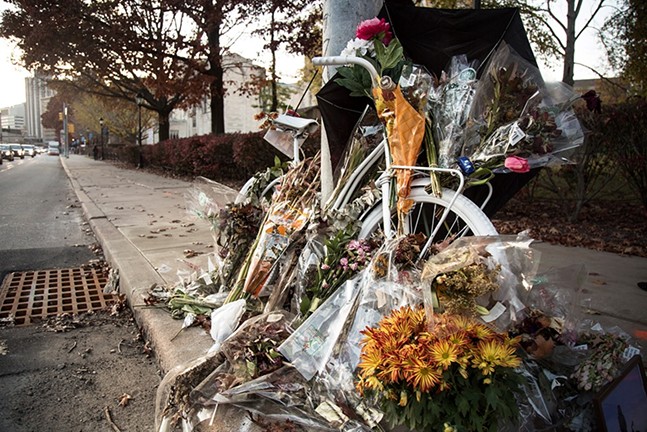
CP Photo: Theo Schwarz
A "ghost bike" commemorating the death of cyclist Susan Hicks on Forbes Avenue
This day of remembrance came after news of events last week where a cyclist was killed after being struck by a driver in Highland Park, and a pedestrian was struck and killed in Duquesne. These followed several other recent fatalities involving car crashes on roads throughout the region, and all are part of a disturbing trend of spiking road fatalities across America.
Anna Tang of advocacy group Bike Pittsburgh organized the memorial and moment of silence, which were held at the Susan Hicks "ghost bike" site near the intersection of Forbes and Bellefield avenues in Oakland. Hicks was killed in 2015 while riding her bike on Forbes Avenue, after being struck and pinned between vehicles. A proposed bill to allow for more parking-protected bike lanes across Pennsylvania has been named after Hicks.
Tang says World Day of Remembrance for Road Traffic Victims is about reflecting over all the lives lost — locally, nationally, and internationally — and about all those involved.
“It is to take a moment to reflect on how many people we have lost. It is also about first responders, and engineers who design the roads. And it is a call to action for safe streets and for Vision Zero,” says Tang, referencing the policy of eliminating traffic deaths in cities. “We want this never to happen again, and in a way, most of these are all preventable deaths.”
According to the U.S. Department of Transportation’s National Highway Traffic Safety Administration, an estimated 20,160 people died in motor vehicle crashes in the first half of 2021, which is an 18.4% increase compared to the same period in 2020, which already saw a spike in traffic fatalities. The 2021 fatality figures are the largest number of projected fatalities in that time period since 2006.
Tang also wanted to bring more attention to the recent “tragedies in Highland Park and Duquesne,” and advocated for the need to think about tangible ways to respond.
According to his obituary, William John Theisen was struck and killed by a vehicle on the 5700 block of Stanton Avenue in Highland Park on Nov. 20. Theisen was 39, worked as a lawyer, and was an avid cyclist. He was an Erie native who returned to Pennsylvania after some time working as a journalist in Southern California, and earned his law degree at the University of Pittsburgh.
“Will was, simply put, an inherently good person to everyone he crossed paths with,” reads his obituary. “He was never short of a kind word, always rooting for the underdog and making an effort to give a voice to anyone he shared a room with.”
The victim killed in the crash in Duquesne was Deveon Franklin, who was just 18 years old. Franklin was struck and killed near the intersection of Route 837 and Hoffman Boulevard at 6 a.m. on Nov. 17. Franklin is survived by his mother Myra Brimage and his father Rodney Franklin Jr., as well as his step father Robert Brimage and several siblings.
Another pedestrian was also struck in this crash in Duquesne, was taken to the hospital, and was pronounced in critical condition.
In both the Highland Park and Duquesne crashes, the driver remained at the scene.
Bike Pittsburgh is advocating for safety improvements for both of these corridors, which have been problems for some time, and are calling on the city of Pittsburgh to institute a Vision Zero plan. Tang says that residents in Highland Park have been asking for more traffic calming to make the streets safer.
City officials have been proactive over the last couple years in redesigning many streets and intersections to get drivers to slow down to make the corridors safer for all road users. However, Tang says the city lacks a Vision Zero policy and wants an official one on the books.
“We are still not a Vision Zero city, and we don’t have a policy in place, and we would love to have one,” says Tang. “There are about 20-25 deaths a year in the city, and a quarter of those involve cyclists or pedestrians."
She notes that it appears that driver behavior is getting more dangerous as the pandemic continues and roads are mostly emptier than they once were, which is encouraging speeding and reckless driving. Tang says that too many people are dying preventable deaths, and that the rise in traffic fatalities should be a clarion call to Pittsburghers and Americans.
“Every 14 minutes, someone dies on a road as a victim of a crash,” says Tang. “Our call is to focus on the safe streets, designing streets that put people first, and getting to Vision Zero.”

